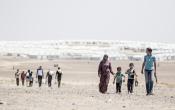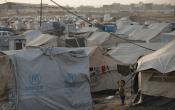Syrian Arab Republic
Operation: Syrian Arab Republic
Location
{"longitude":39,"latitude":35,"zoom_level":0}
Latest update of camps and office locations 21 Nov 2016. By clicking on the icons on the map, additional information is displayed.
Key Figures
| 2016 year-end results | |
| 4,080,000 | IDPs received core relief items, of whom, 83 per cent were reached from inside Syria and 17 per cent through cross-border operations from Turkey and Jordan |
| 2,012,000 | IDPs were reached with protection and community services |
| 92,000 | IDPs were assisted with shelter interventions |
| 47,000 | IDPs and individuals from the host community benefitted from vocational and life-skills trainings, of whom over 979 IDPs benefited from small start-up business grants |
| 21,000 | refugees and 696,000 IDPs received primary and emergency healthcare |
| 11,000 | refugee households received regular cash assistance to cover for their basic needs |
| 2017 planning figures | |
| 2.9 million | IDPs will benefit from non-food item distribution |
| 180,000 | IDPs will receive legal assistance |
| 150,000 | IDPs will benefit from emergency shelter interventions |
| 150,000 | vulnerable IDP students will benefit from remedial and catch-up classes |
| 80,000 | IDPs will benefit from livelihood activities including vocational training and small start-up business grants |
Latest Updates and Related Links
People of Concern
6%
Increase in
2016
2016
| 2016 | 7,131,910 |
| 2015 | 6,753,569 |
| 2014 | 7,947,655 |

[["Refugees",19809],["Asylum-seekers",12494],["IDPs",6325978],["Returned IDPs",600000],["Returned refugees",1],["Stateless",160000],["Others of concern",13628]]
Loading ...
Syrian Arab Republic
< Back
2016
{"categories":[2012,2013,2014,2015,2016,2017],"budget":[156.31257923,317.92470594,331.41534753,366.77411747,315.69039415,497.60006813],"expenditure":[123.37618395,231.88147006,205.04924968,173.76697349,137.49994288,null]}
{"categories":[2012,2013,2014,2015,2016,2017],"p1":[114.05797994,84.23797468,69.84079225,56.81599041,52.75013228,47.39999955],"p2":[0.49529929,0.70832734,0.57833829,0.17973042,0.1946423,0.21116958],"p3":[null,null,null,null,null,146],"p4":[41.7593,232.97840392,260.99621699,309.77839664,262.74561957,303.988899]}
{"categories":[2012,2013,2014,2015,2016,2017],"p1":[89.18652361,40.80187504,40.86751359,23.27234083,23.57270191,null],"p2":[0.20035572,0.29587007,0.44117528,0.12660126,0.10932031,null],"p3":[null,null,null,null,null,null],"p4":[33.98930462,190.78372495,163.74056081,150.3680314,113.81792066,null]}
Loading ...
CHOOSE A YEAR
- 2014
- 2015
- 2016
- 2017
Working environment
The humanitarian situation in the Syrian Arab Republic (Syria) continued to drive unprecedented levels of displacement and suffering with more than 13.5 million people in need of humanitarian assistance, among them 6.3 million internally displaced. Despite improved access to population in some parts of the country, the delivery of aid continued to be hampered by active conflict and general insecurity. The scale of needs remained staggering as four out of five Syrians live in poverty while access to basic services has been severely disrupted due to the conflict, aggravating the vulnerabilities of the civilian population across the country.In a complex and most challenging context, UNHCR remained the main operational agency leading the protection, shelter/non-food items (NFI), and camp coordination and camp management (CCCM) sectors in line with the inter-agency humanitarian response and in the context of Whole of Syria approach. UNHCR continued to deliver cross-line and cross-border assistance to affected populations with coordination hubs in Jordan and Turkey supporting cross-border assistance.
Population trends
- Some 6.3 million people were internally displaced at the end of 2016. While fresh displacements continued throughout 2016, nearly 600,000 spontaneous IDP returns took place.
- The number of registered urban refugees and asylum seekers in Syria (mostly from Iraq) increased to 32,000 from 26,000 at the end of 2015. Additionally, some 14,000 Iraqi asylum-seekers resided in Al-Hol, Roj and Newroz camps in Al-Hassakeh Governorate, including 10,000 who arrived in Al-Hol camp in 2016.
Achievements and impact
- UNHCR reached more than 2 million IDPs and affected community members with protection services.
- 52 new community centres were established bringing the total to 74 in 11 governorates, close to 1,800 outreach volunteers were mobilized, and 25 mobile units were activated to provide services in remote communities. Despite limited funding, UNHCR maintained refugee reception and counselling services, registration, refugee status determination, resettlement, community services, legal assistance, financial assistance and other services for refugees and asylum-seekers.
Unmet needs
- 26 community centres could not be established through which an additional 312,000 IDPs and affected community members could have been reached with critical protection services.
- Comprehensive health needs could not be met. Some additional 50,000 IDPs could have been assisted by UNHCR with health services in various parts of the country had access and sufficient funding been made available.
- Site preparation and construction of various facilities in Al-Hol camp could not be completed.
By mid-2015, an estimated 12.2 million of the 22 million population of the Syrian Arab Republic (Syria) have been affected by the conflict through: its impact on infrastructure, including schools and hospitals; the limited availability of medicines and basic commodities; lack of access to social services; and the deepening economic recession. This has left many exposed to a range of risks related to living in inadequate accommodation; limited access to healthcare, education and justice; loss of documentation; as well as the dangers of child labour and gender-based violence.
In 2016, UNHCR will maintain its inter-agency coordination role for protection and community services under the framework of the Strategic Response Plan (SRP), with the aim of responding to the impact of the armed conflict, general insecurity and human rights violations on the civilian population, and promoting measures to enhance the protection of internally displaced people (IDPs). As lead agency for the shelter and non-food items sectors, the provision of core relief items will continue to be a major component of UNHCR’s IDP response. Assistance will be delivered both from inside Syria, as well as from the neighbouring countries of Jordan and Turkey. The Office is committed to strengthening coordination and communication amongst all stakeholders, including beneficiaries, local communities, and national and international non-governmental organizations, in line with the “Whole of Syria” approach.
Further, refugees in Syria have been severely affected by the crisis and currently face additional protection risks due to forced internal relocation. This often results in family separation, exposing children, women-headed households, the elderly and people with disabilities to heightened risks. Ensuring cash assistance to support refugees’ basic food and shelter needs and addressing vulnerabilities, will be priorities in 2016.






